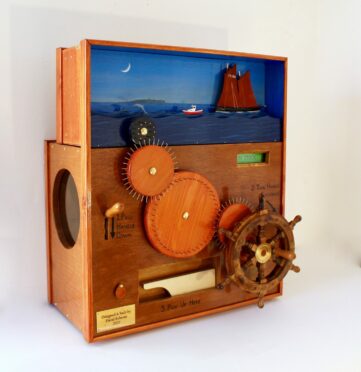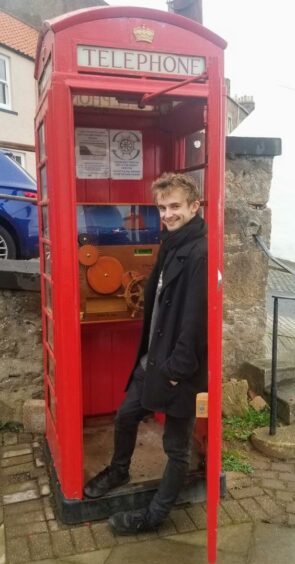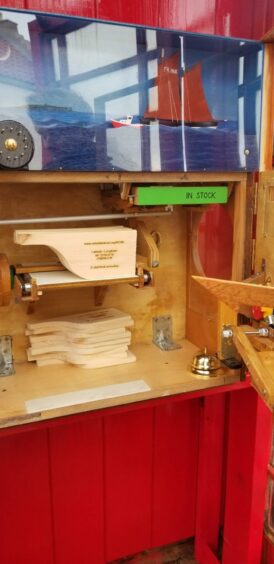David Behrens has had a long wait to see his kinetic art creation installed in a phone box in Cellardyke. Now, finally in situ, the beautiful hand-built piece invites visitors to turn the handle to access a wooden message in a bottle to send out to sea.
David Behrens is the Pittenweem-born artist who is responsible for the beautiful hand-built message in a bottle vending machine which currently has pride of place in a phone box by Cellardyke Harbour. The machine, which harks back to the age of automata, vending machines and mechanical fortune tellers of the late nineteenth century, invites visitors to turn a wheel to access a wooden message in a bottle to send out to sea.
Nostalgic machines
David (23) describes his own work as “weird art that moves” but he’s doing himself a disservice. His creation for the phone box at Cellardyke harbour is a beautiful labour of love, bringing together his own loves of music, art, design and passion for machinery that time forgot.
The quirky movement, characteristic tinkling music-box sound and choice of French classic La Mer by Charles Trenet all add to the sense of nostalgia conjured up by David’s vending machine.
The recently graduated artist and musician (he left Edinburgh University with first class honours in music last year) was commissioned by Cellardyke Trust to design a vending machine to be installed in a disused red phone box by the village’s harbour. The iconic phone box was saved from demolition by the trust and sits on a spectacular site just above the village’s harbour with stunning views out to sea.
Kinetic art
David’s work was already known to the trust, “I was working for the East Neuk Festival during lockdown,” he explains, “I made quite a few films and wrote music for an event at the Dreel Hall.” He has also exhibited some of his kinetic art in Pittenweem, ““I’m obsessed with anything that moves – I was always fascinated with it,” he explains, “I felt that there was a lack of kinetic art out there so I started doing things similar to this with jumping dolphins and purely abstract mobile pieces with sea glass.”
For the phone box project, the idea of a message in a bottle was already up and running and David’s model was to be a continuation of that theme: “they got local schools to design model boats that sailed out to sea. Then we wanted to find a way to keep the project going. The idea is that you could have wooden postcards, take them to the sea and send a message from Cellardyke out into the world.”
Community involvement
The project has been a real community effort. The wooden postcards dispensed by the machine are being made by the local Men’s Shed, with text engraved by Laserflair. Anyone who finds a postcard can trace it back to Cellardyke Harbour via the weblink, co-ordinates or what3words address.
The next challenge was to come up with an interesting way for people to access the postcards and that’s where David came in. “They asked me to come up with a machine in the style of an old vending machine.”
“I have used reconditioned old machinery and built all the pieces,” which he admits has been difficult because he doesn’t have any formal training in metal-work. He sourced an original ship’s wheel to add a nautical finishing touch to his machine. Other tests included making sure that the well-known local fishing boat Reaper was accurately portrayed in his model.
“I finished uni in May 2020 and it turned into a bit of a project. From June to October I was basically working solely on this. Plugging away when I had a spare moment,” he explains.
A golden age of machines
Looking back to the roots of his fascination with all things mechanical, David admits that he was the kind of small boy who would take things apart to find out how they worked; “I especially love clocks and anything clockwork based – in another life I would have been a clockmaker!”
Films such as the beautiful Hugo, which focuses on the journey to rebuild an automaton in 1930s Paris draw the artist in, as do fantastical machines like The Millennium Clock Tower at the National Museum of Scotland and the incredible Sharmanka Kinetic Theatre in Glasgow. Now, 300 hours of labour later, his own tribute to the golden age of the automaton has been installed in Cellardyke for others to enjoy.
David has also produced a film documenting the making of his machine, which is available to view on his Instagram account.


